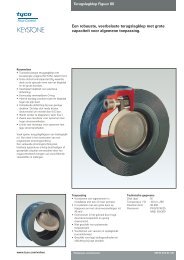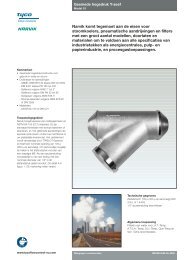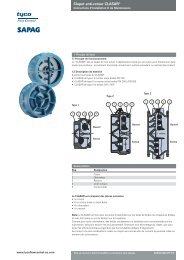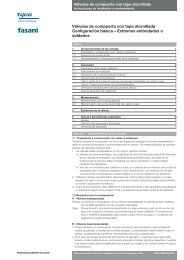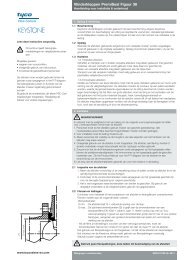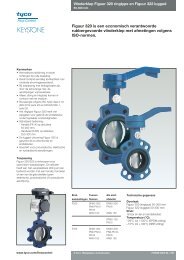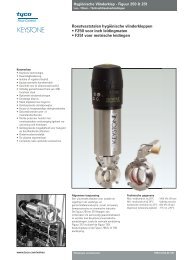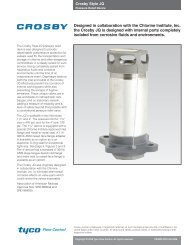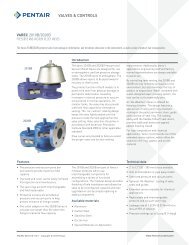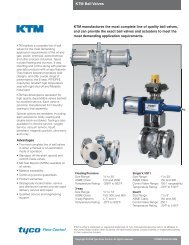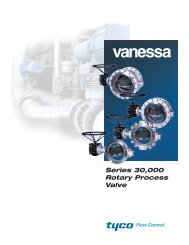Direct contact and metal-to-metal seating make the T-pattern globe ...
Direct contact and metal-to-metal seating make the T-pattern globe ...
Direct contact and metal-to-metal seating make the T-pattern globe ...
Create successful ePaper yourself
Turn your PDF publications into a flip-book with our unique Google optimized e-Paper software.
Hancock 7000 Series<br />
T-Pattern Globe S<strong>to</strong>p Valves<br />
Maintenance Features<br />
Service <strong>and</strong> Repair Tools for<br />
In-Line Valve Maintenance<br />
Hancock High Pressure “No Bonnet<br />
Joint” valves are designed <strong>to</strong> meet<br />
<strong>the</strong> requirements of <strong>the</strong> electrical power<br />
industry's high pressure/high<br />
temperature steam generating plants,<br />
as well as <strong>the</strong> high pressure requirements<br />
of <strong>the</strong> process industry. This valve's one<br />
piece body design offers simplicity of<br />
disassembly <strong>and</strong> maintenance without<br />
removing <strong>the</strong> valve from <strong>the</strong> line. There<br />
are no bonnet bolts <strong>to</strong> undo, no welds <strong>to</strong><br />
break <strong>and</strong> no gaskets <strong>to</strong> replace.<br />
Step #1: Upset material holding thread<br />
bushing <strong>to</strong> yoke is removed first, by filing.<br />
Step #3: Using stem as a jack screw, it is<br />
turned as when opening valve, <strong>to</strong> lift packing<br />
out of stuffing box. When <strong>the</strong> last thread of <strong>the</strong><br />
stem <strong>make</strong>s up on <strong>the</strong> thread bushing,<br />
bushing is backed off <strong>and</strong> split gl<strong>and</strong>s<br />
inserted, as shown in pho<strong>to</strong>. This allows more<br />
jacking height when removing packing from<br />
stuffing box.<br />
The maintenance <strong>to</strong>ols illustrated,<br />
<strong>and</strong> <strong>the</strong> procedures described in <strong>the</strong><br />
maintenance manual, are designed <strong>to</strong><br />
facilitate in-line valve service <strong>and</strong> repair<br />
in a minimum of time, without sacrificing<br />
maintenance quality or requiring special<br />
training of maintenance personnel.<br />
These valves offer design simplicity<br />
for long trouble-free service <strong>and</strong> easy<br />
in-line maintenance. In five simple<br />
steps, <strong>the</strong> Hancock valve can be<br />
completely disassembled, ready<br />
for inspection <strong>and</strong> easily accessible<br />
for in-line repair.<br />
Step #2: Packing gl<strong>and</strong> nuts are <strong>the</strong>n<br />
removed, gl<strong>and</strong> flange is lifted <strong>and</strong> split<br />
gl<strong>and</strong>s removed. Thread bushing <strong>and</strong><br />
h<strong>and</strong>wheel nut are loosened.<br />
Step #4: Stem assembly is<br />
completely removed. Valve<br />
is ready for lapping.<br />
Copyright © 2009 Tyco Flow Control. All rights reserved. HANMC-0354<br />
6<br />
Step #5: Valve is completely<br />
disassembled, ready for inspection<br />
<strong>and</strong> accessible for repair, if<br />
necessary.



